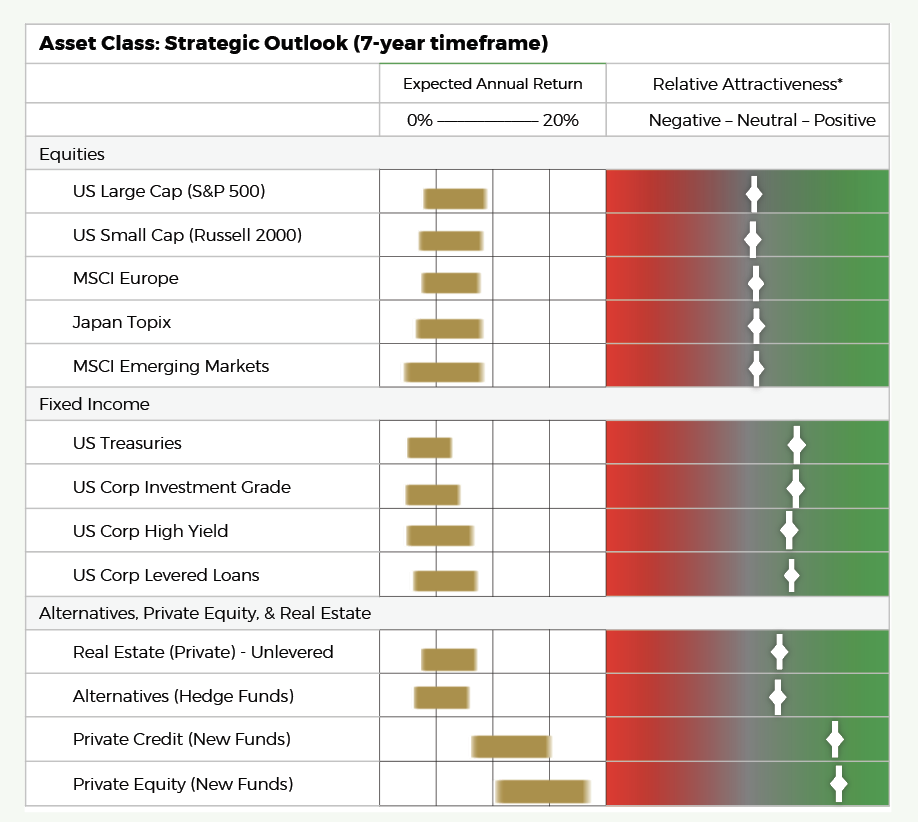Our 7-year forecasts consider several factors that will shape the mid-term investment landscape.

Note*: The attractiveness of each asset class (as depicted by the positioning of the sliders) is based upon risk-adjusted returns when considering expected returns, volatility, and liquidity. Thus, US Treasuries with mid-single digit returns are shown as quite attractive given a low-risk profile whereas public equities are only rated modestly attractive despite their higher expected return as equities have much greater volatility.
Macroeconomic and Market Factors
Interest Rates Outlook: We anticipate that interest rates will decline from current levels over the forecast period, but they are unlikely to return to the ultra-low levels experienced from 2009 to 2021.
Corporate Profit Margins: Margins (especially in the US) will be affected by opposing forces. Onshoring and reduced labor flexibility may exert downward pressure, while AI adoption could significantly boost productivity and expand profit margins, particularly in the U.S.
Geopolitical Risks: Heightened geopolitical uncertainty—stemming from the U.S.-China relationship, conflicts in the Middle East, and the potential for other military tensions—will likely influence market volatility and investment strategies.
Equity Market Outlook
Expected Returns: With valuations having significantly increased over the last 18 months, we forecast mid-single digit nominal pre-tax annual equity returns (6.0%-7.0%) over the next seven years.
U.S. vs. International Markets: While U.S. stocks are expected to outperform international equities, we anticipate a greater convergence in returns due to elevated U.S. valuations. International markets are generally aligned with historical averages, making them potentially more attractive from a relative valuation perspective.
Growth vs. Value Stocks: Quality and growth stocks are expected to continue outperforming value stocks, though at a slower pace compared to the past seven years. For U.S. equities, earnings growth and dividends are likely to be the primary drivers of returns, rather than multiple expansion.
Potential Wildcards: The adoption pace of generative AI could significantly impact U.S. tech sectors, potentially leading to above-trend revenue growth and margin expansion. Conversely, should AI capex spend decline from extremely robust current levels or revenue monetization from AI prove lower than expected, several US large-cap technology stocks may experience muted stock performance. Given their high concentration in the index, S&P 500 performance might be heavily influenced by the performance of a select number of stocks.
Fixed Income Outlook
Attractive Base Yields: “Safe” fixed income remains appealing, with base yields across the curve above 4.0% for maturities between 2 and 10 years. U.S. 10-Year Treasuries currently yield 4.1%, down from 4.7% in April but higher than the 3.6% recent lows. We expect yields to remain within a 3.50% to 4.50% range in the near term, with a greater likelihood of falling below the lower end.
Expected Returns: We project low-to-mid-single digit returns for U.S. government debt and investment-grade bonds over the 7-year horizon. On a risk-adjusted pre-tax basis, the return potential for safe fixed income remains attractive compared to equities.
Credit Market Outlook
Riskier Credit Assets: High-yield bonds are yielding 7.2%, while leveraged loans offer 9.2% yields. Expected returns for these assets are in the range of 6.0%-6.5%. The high base yields make these options appealing for generating current income.
Spread Considerations: Current high-yield spreads (300 bps) are below historical averages and far below recessionary levels (600-800 bps). If a recession occurs, spreads may widen, negatively impacting near-term prices, but high starting yields could cushion total returns.
Comparative Attractiveness: Despite tighter spreads, risky credit remains attractive relative to equities on a pre-tax basis, though it is less compelling compared to safe government bonds.
Alternative Investment Outlook
Private Market Strategies: We expect private equity and private credit to deliver higher returns relative to public markets over a multi-year period. Private equity secondaries, specialty finance, and asset-backed credit remain appealing areas for new investments given their potential for superior returns and diversification benefits.



